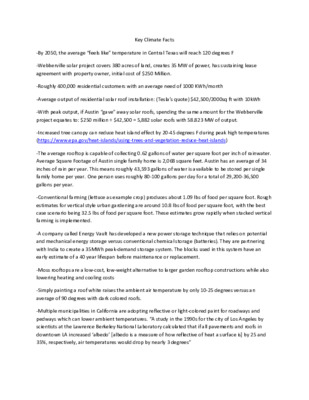20191028-003d 4 — original pdf
Backup

Key Climate Facts ‐By 2050, the average “feels like” temperature in Central Texas will reach 120 degrees F ‐Webberville solar project covers 380 acres of land, creates 35 MW of power, has sustaining lease agreement with property owner, initial cost of $250 Million. ‐Roughly 400,000 residential customers with an average need of 1000 KWh/month ‐Average output of residential solar roof installation: (Tesla’s quote) $42,500/2000sq ft with 10kWh ‐With peak output, if Austin “gave” away solar roofs, spending the same amount for the Webberville project equates to: $250 million ÷ $42,500 = 5,882 solar roofs with 58.823 MW of output. ‐Increased tree canopy can reduce heat island effect by 20‐45 degrees F during peak high temperatures (https://www.epa.gov/heat‐islands/using‐trees‐and‐vegetation‐reduce‐heat‐islands) ‐The average rooftop is capable of collecting 0.62 gallons of water per square foot per inch of rainwater. Average Square Footage of Austin single family home is 2,068 square feet. Austin has an average of 34 inches of rain per year. This means roughly 43,593 gallons of water is available to be stored per single family home per year. One person uses roughly 80‐100 gallons per day for a total of 29,200‐36,500 gallons per year. ‐Conventional farming (lettuce as example crop) produces about 1.09 lbs of food per square foot. Rough estimates for vertical style urban gardening are around 10.8 lbs of food per square foot, with the best case scenario being 32.5 lbs of food per square foot. These estimates grow rapidly when stacked vertical farming is implemented. ‐A company called Energy Vault has developed a new power storage technique that relies on potential and mechanical energy storage versus conventional chemical storage (batteries). They are partnering with India to create a 35MWh peak‐demand storage system. The blocks used in this system have an early estimate of a 40 year lifespan before maintenance or replacement. ‐Moss rooftops are a low‐cost, low‐weight alternative to larger garden rooftop constructions while also lowering heating and cooling costs ‐Simply painting a roof white raises the ambient air temperature by only 10‐25 degrees versus an average of 90 degrees with dark colored roofs. ‐Multiple municipalities in California are adopting reflective or light‐colored paint for roadways and pedways which can lower ambient temperatures. “A study in the 1990s for the city of Los Angeles by scientists at the Lawrence Berkeley National Laboratory calculated that if all pavements and roofs in downtown LA increased ‘albedo’ [albedo is a measure of how reflective of heat a surface is] by 25 and 35%, respectively, air temperatures would drop by nearly 3 degrees”